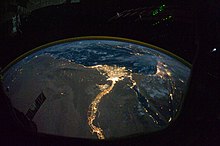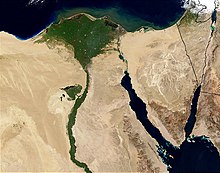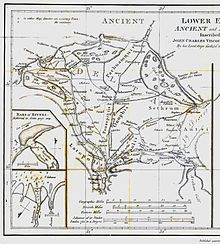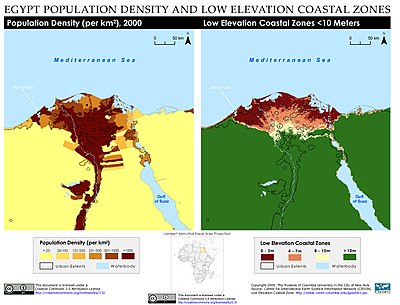Nile Delta


TheNile Delta(Arabic:دلتا النيل,Delta an-Nīlor simplyالدلتا,ad-Delta)is thedeltaformed inLower Egyptwhere theNileRiver spreads out and drains into theMediterranean Sea.[1]It is one of the world's larger deltas—fromAlexandriain the west toPort Saidin the east; it covers 240 km (150 mi) of the Mediterranean coastline and is a richagriculturalregion.[2]From north to south the delta is approximately 160 km (100 mi) in length. The Delta begins slightly down-river fromCairo.[3]
Geography
[edit]From north to south, the delta is approximately 160 km (100 mi) in length. From west to east, it covers some 240 km (150 mi) of coastline. The delta is sometimes divided into sections, with the Nile dividing into two maindistributaries,theDamiettaand theRosetta,[4]flowing into the Mediterranean at port cities with the same name. In the past, the delta had several distributaries, but these have been lost due to flood control, silting and changing relief. One such defunct distributary isWadi Tumilat.

TheSuez Canalis east of the delta and enters the coastalLake Manzalain the north-east of the delta. To the north-west are three other coastal lakes or lagoons:Lake Burullus,Lake IdkuandLake Mariout.
The Nile is considered to be an "arcuate" delta (arc-shaped), as it resembles a triangle or flower when seen from above. Some scholars such as Aristotle have written that the delta was constructed for agricultural purposes due to the drying of the region of Egypt.[5]
In modern day, the outer edges of the delta are eroding, and some coastal lagoons have seen increasing salinity levels as their connection to the Mediterranean Sea increases. Since the delta no longer receives an annual supply of nutrients and sediments from upstream due to the construction of theAswan Dam,the soils of the floodplains have become poorer, and large amounts of fertilizers are now used.Topsoilin the delta can be as much as 21 m (70 ft) in depth.
History
[edit]
People have lived in the Nile Delta region for thousands of years, and it has been intensively farmed for at least the last five thousand years. The delta was a major constituent of Lower Egypt, and there are many archaeological sites in and around the delta.[6]Artifacts belonging to ancient sites have been found on the delta's coast. TheRosetta Stonewas found in the delta in 1799 in the port city of Rosetta (an anglicized version of the nameRashid). In July 2019 a small Greek temple, ancient granite columns, treasure-carrying ships, and bronze coins from the reign ofPtolemy II,dating back to the third and fourth centuries BC, were found at the sunken city ofHeracleion,colloquially known as Egypt's Atlantis. The investigations were conducted by Egyptian and European divers led by the underwater archaeologistFranck Goddio.They also uncovered a devastated historic temple (the city's main temple) underwater off Egypt's north coast.[7][8][9][10]
In January 2019 archaeologists led byMostafa Waziriworking in the Kom Al-Khelgan area of the Nile Delta discovered tombs from theSecond Intermediate Periodand burials from theNaqada IIera. The burial site contained the remains of animals,amuletsand scarabs carved fromfaience,round and oval pots with handles, flint knives, broken and burned pottery. All burials included skulls and skeletons in the bending position and were not very well-preserved.[11][12]
Ancient branches of the Nile
[edit]
Records from ancient times (such as byPtolemy) reported that the delta had sevendistributariesor branches, (from east to west):[4]
- thePelusiac
- theTanitic
- theMendesian
- the Phatnitic or Phatmetic (later theDamietta)
- theSebennytic
- the Bolbitine (later theRosetta)[13]
- theCanopic(also called the Herakleotic,[14]Agathodaemon[15])
George of Cypruslist[16]
[edit]- Alexandrian (Schedia canal)
- Colynthin (Canopic)
- Agnu(Rosetta)
- Parollos (Burullus)
- Chasmatos (Baltim)
- Tamiathe (Damietta)
- Tenese (Tinnis)
Modern Egyptologists suggest that in the Pharaonic era there were at a time five main branches:[17][18]
- the Pelusiac
- the Sebennytic
- the Canopic
- the Damietta
- the Rosetta
The first three have dried up over the centuries due toflood control,siltingand changing relief, while the last two still exist today. TheDelta used to flood annually,but this ended with the construction of theAswan Dam.
Population
[edit]
About 39 million people live in the Delta region. Outside of major cities, population density in the delta averages 1,000/km2(2,600/sq mi) or more.Alexandriais the largest city in the delta with an estimated population of more than 4.5 million. Other large cities in the delta includeShubra El Kheima,Port Said,El Mahalla El Kubra,Mansura,Tanta,andZagazig.[19]
Wildlife
[edit]
Duringautumn,parts of the Nile River are red withlotus flowers.The Lower Nile (North) and the Upper Nile (South) have plants that grow in abundance. The Upper Nile plant is the Egyptian lotus, and the Lower Nile plant is the Papyrus Sedge (Cyperus papyrus), although it is not nearly as plentiful as it once was, and is becoming quite rare.[20]
Several hundred thousand water birds winter in the delta, including the world's largest concentrations oflittle gullsandwhiskered terns.Other birds making their homes in the delta includegrey herons,Kentish plovers,shovelers,cormorants,egretsandibises.
Other animals found in the delta includefrogs,turtles,tortoises,mongooses,and theNile monitor.Nile crocodilesandhippopotamus,two animals which were widespread in the delta during antiquity, are no longer found there. Fish found in the delta include theflathead grey mulletand soles.
Climate
[edit]The Delta has ahot desert climate(Köppen:BWh) as the rest of Egypt, but its northernmost part, as is the case with the rest of thenorthern coast of Egyptwhich is the wettest region in the country, has relatively moderate temperatures, with highs usually not surpassing 31 °C (88 °F) in the summer. Only 100–200 mm (4–8 in) of rain falls on the delta area during an average year, and most of this falls in the winter months. The delta experiences its hottest temperatures in July and August, with a maximum average of 34 °C (93 °F). Winter temperatures normally range from 9 °C (48 °F) at nights to 19 °C (66 °F) in the daytime. With cooler temperatures and some rain, the Nile Delta region becomes quite humid during thewintermonths.[21]
Sea level rise
[edit]
Egypt's Mediterranean coastline experiences significant loss of land to the sea, in some places amounting to 90 m (100 yd) a year. The low-lying Nile Delta area in particular is vulnerable tosea level riseassociated withglobal warming.[22]This effect is exacerbated by the lack of sediments being deposited since the construction of theAswan Dam.If the polar ice caps were to melt, much of the northern delta, including the ancient port city ofAlexandria,could disappear under the Mediterranean. A 30 cm (12 in) rise in sea level could affect about 6.6% of the total land cover area in the Nile Delta region. At 1 m (3 ft 3 in) sea level rise, an estimated 887 thousand people could be at risk of flooding and displacement and about 100 km2(40 sq mi) of vegetation, 16 km2(10 sq mi) wetland, 402 km2(160 sq mi) cropland, and 47 km2(20 sq mi) of urban area land could be destroyed,[23]flooding approximately 450 km2(170 sq mi).[24]Some areas of the Nile Delta'sagricultural landhave been rendered saline as a result of sea level rise; farming has been abandoned in some places, while in others sand has been brought in from elsewhere to reduce the effect. In addition toagriculture,the delta'secosystemsand tourist industry could be negatively affected by global warming. Food shortages resulting from climate change could lead to seven million "climate refugees" by the end of the 21st century. Nevertheless, environmental damage to the delta is not currently one of Egypt's priorities.[25]
The delta's coastline has also undergone significant changes ingeomorphologyas a result of the reclamation of coastal dunes and lagoons to form new agricultural land andfish farmsas well as the expansion of coastal urban areas.[26]
Governorates and large cities
[edit]The Nile Delta forms part of these 10governorates:
Large cities located in the Nile Delta:
References
[edit]- ^Dumont, Henri J. (6 May 2009).The Nile: Origin, Environments, Limnology and Human Use.Springer Science & Business Media. p. 88.ISBN978-1-4020-9726-3.
- ^Negm, Abdelazim M. (25 May 2017).The Nile Delta.Springer. p. 36.ISBN978-3-319-56124-0.
- ^Zeidan, Bakenaz. (2006). The Nile Delta in a global vision. Sharm El-Sheikh.,archived fromthe originalon 10 July 2020,retrieved10 July2020
- ^abJohn Cooper (30 September 2014).The Medieval Nile: Route, Navigation, and Landscape in Islamic Egypt.The American University in Cairo Press. p. 76.ISBN978-977-416-614-3.
- ^Holz, Robert K (1969).Man-made landforms in the Nile delta.American Geographical Society.OCLC38826202.
- ^Location of the site,Kafr Hassan Dawood On-Line, with a map of early sites of the delta.
- ^"Mysterious temple discovered in the ruins of sunken ancient city".9news.au.26 July 2019.Retrieved17 August2019.
- ^History, Laura Geggel 2019-07-29T10:37:58Z (29 July 2019)."Divers Find Remains of Ancient Temple in Sunken Egyptian City".livescience.Retrieved17 August2019.
{{cite web}}:CS1 maint: numeric names: authors list (link) - ^Santos, Edwin (28 July 2019)."Archaeologists discover a sunken ancient settlement underwater".Nosy Media.Archived fromthe originalon 17 August 2019.Retrieved17 August2019.
- ^EDT, Katherine Hignett On 7/23/19 at 11:06 AM (23 July 2019)."Ancient Egypt: Underwater archaeologists uncover destroyed temple in the sunken city of Heracleion".Newsweek.Retrieved17 August2019.
{{cite web}}:CS1 maint: numeric names: authors list (link) - ^"3,500-Year-Old Tombs Unearthed in Egypt's Nile Delta - Archaeology Magazine".archaeology.org.Retrieved11 September2020.
- ^"Ancient tombs and prehistoric burials found in Nile Delta - Ancient Egypt - Heritage".Ahram Online.Retrieved11 September2020.
- ^Hayes, W. 'Most Ancient Egypt', p. 87,Journal of Near Eastern Studies,23 (1964), 73–114.
- ^e.g. atCallisthenesAlexander 1.31.
- ^e.g. in Ptolemy,Geography.
- ^Cooper, John Peter (2008).The Medieval Nile: Route, navigation and landscape in Islamic Egypt.p. 34.
- ^Shaw, Ian; Nicholson, Paul (1995).The Dictionary of Ancient Egypt.London:British Museum Press.p. 83.
- ^Margaret Bunson,Encyclopedia of Ancient Egypt.Infobase Publishing, 2009,ISBN1438109970,p. 98.
- ^City Population website,citing Central Agency for Public Mobilisation and Statistics Egypt (web), accessed 11 April 1908.
- ^Beentje, H.J.; Lansdown, R.V. (2018)."Cyperus papyrus".IUCN Red List of Threatened Species.2018:e.T164158A120152171.doi:10.2305/IUCN.UK.2018-2.RLTS.T164158A120152171.en.Retrieved11 November2021.
- ^Nile Delta Facts
- ^"Global Warming Threatens Egypt's Coastlines and the Nile Delta".EcoWorld.25 September 2009. Archived fromthe originalon 29 September 2011.Retrieved22 August2019.
- ^Hasan, Emad; Khan, Sadiq Ibrahim; Hong, Yang (2015). "Investigation of potential sea level rise impact on the Nile Delta, Egypt using digital elevation models".Environmental Monitoring and Assessment.187(10): 649.doi:10.1007/s10661-015-4868-9.PMID26410824.S2CID207139887.
- ^"Egypt's Nile Delta falls prey to climate change".28 January 2010.
- ^"Egypt fertile Nile Delta falls prey to climate change".Egypt News.28 January 2010. Archived fromthe originalon 9 February 2011.Retrieved22 August2019.
- ^El Banna, Mahmoud M.; Frihy, Omran E. (2009). "Human-induced changes in the geomorphology of the northeastern coast of the Nile delta, Egypt".Geomorphology.107(1): 72–78.Bibcode:2009Geomo.107...72E.doi:10.1016/j.geomorph.2007.06.025.
External links
[edit]Nile Delta.
- "Nile Delta flooded savanna".Terrestrial Ecoregions.World Wildlife Fund.
- Adaptationlearning.net: UN project for managing sea level rise risks in the Nile Delta
- "The Nile Delta".Keyway Bible Study.Archived fromthe originalon 2 August 2010.

